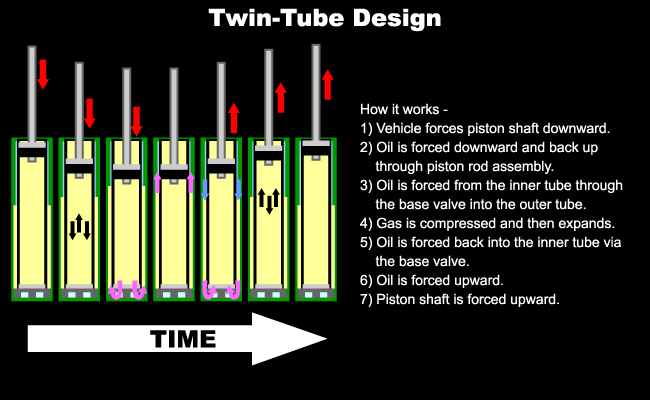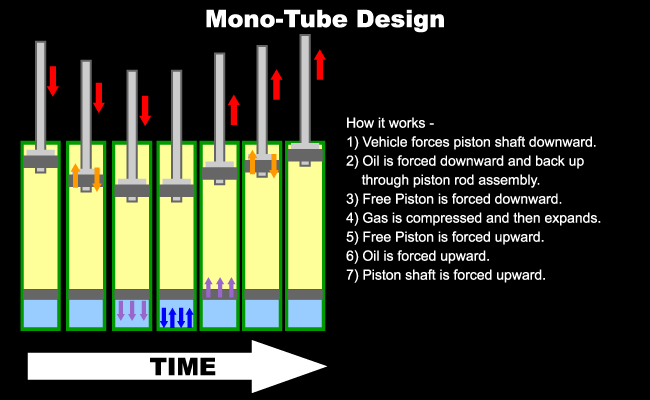| HOME // CLASSROOM // Lesson 1 – Suspension Basics |
 |
 |
 |
| Springs and Struts/ Shocks |
| I approach this section with more of an emphasis on the heart of a suspension, the springs and dampers (struts/ shocks). Now there are many definitions to what exactly a spring or damper does. For me, at the most basic level; springs control the amount the suspension moves up and down. The dampers control the speed at which the suspension moves. In terms of driving, the springs control the amount of squat, dive, and roll angle. While the dampers control the speed of those movements. The combination of spring rate and damping force (damper valving), basically determines the ride quality and performance of the suspension (of course sway bar, suspension geometry, bushings, etc… are also factors but I want to keep it simple for now). |
 |
| Types of Springs |
 |
There are two basic types of springs, progressive and linear. A progressive spring is one in which the spring rate varies depending on the amount of load placed on the spring. So the actual spring rate is not a fixed number, it is more of a range. OEM vehicle springs and most lowering springs (including TEIN) are almost all progressive type springs. They offer good performance and ride when the damper length is set, meaning no adjustable spring seat or length.
The second type is linear springs, which have a fixed spring rate. This means the amount of weight needed to compress the spring a certain amount does not change. Linear type springs are used on most coilover type suspensions. All TEIN coilovers utilize a linear spring, as do many other brands of coilovers. Linear springs make performance more consistent as the driver can better anticipate the suspension movement. |
|
 |
| Struts and Shocks |
|
| Many people interchange the words struts and shocks. They are virtually the same thing but just are design types. A strut, is used on McPherson type suspensions. A shock is the type used on multi-link, double A-arm, H-beam, etc.... type suspensions. In actuality they are the same thing, a damper. A unit that dampens force. |
 |
MacPherson Strut Type - A design in which the strut connects the hub assembly directly to the chassis of the vehicle. No upper arm is used to control the movement of the hub. This design usually allows the camber and caster angle of the suspension to be adjusted from the upper mounts.
Ex: Nissan 240SX (Front), Subaru WRX (All), Mitsubishi EVO (Front), Acura RSX (Front), etc... |
 |
Shock Absorber Type - Independent or multi-link type suspensions utilize a shock. An upper and lower control are used to control movement of the hub. (double A-Arm, wishbone, etc...). This design does not allow camber or caster adjustment to be made from the upper mounts.
Ex: Acura Integra (All), Lexus IS300 (All), Nissan 350Z (All), Toyota Supra (All), etc.. |
 |
|
 |
|
 |
| Types of Damper Designs |
| There are various types of damper designs. We will stick with the two most popular, which are twin tube and mono tube gas filled. |
 |
 |
 |
| Twin tube - Utilizes an inner and outer tube which separates the oil and gas inside the damper. The smaller diameter inner tube houses the piston shaft assembly, base valve, and oil. The outer tube contains both nitrogen gas and damper oil. You can see in the below diagram, how a basic twin tube works. |
 |
| The twin tube design is the most common, and is the OEM design found on the majority of vehicles. This design has the benefit of having a greater piston stroke to damper body ratio, meaning more piston movement in a smaller total package. It also is more durable for street use as the outer casing can take a dent, and continue to function so long as the inner tube is not damaged. |
 |
 |
 |
| Mono tube - Only uses a single outer tube. The oil and gas are separated by a free piston, which puts the oil on the top and gas on the bottom. You can see in the below diagram, how a basic mono tube works. |
 |
| The mono tube is found in some OEM vehicle applications, mainly higher end more performance vehicles. EVO MR, Porsche, etc…The benefits to the mono tube design are larger internal parts, which means greater damping force, increased oil capacity, improved heat dissipation, and the ability to function when inverted. |
 |
 |
 |
| Please come back for lesson 2, which will cover how adjustable dampers work, and some basic suspension tuning. |
 |
If you have any specific questions regarding this lesson, please E-mail your questions to:
 , with Subject Line - TEIN CLASSROOM , with Subject Line - TEIN CLASSROOM |
 |
|
|









